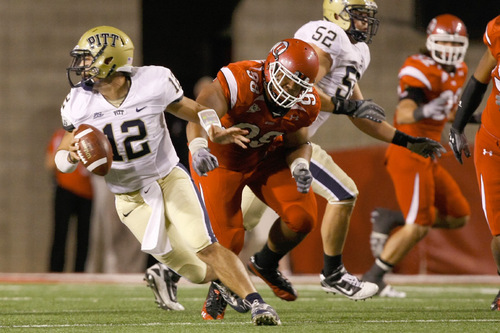This is an archived article that was published on sltrib.com in 2010, and information in the article may be outdated. It is provided only for personal research purposes and may not be reprinted.
Even after a half-century of Thanksgiving dinners, usually eaten after watching my hometown Detroit Lions lose, I can offer absolutely no advice about preparing the stuffing, baking the pies or carving the turkey.
I can, however, provide information to help anyone join in the conversation, as BYU and Utah prepare to play once more in their post-Thanksgiving time slot.
My tip: Invoke the name of Ute defensive lineman Sealver Siliga (that's "Sil-ver See-linga") and nod knowingly.
Because for all the X's and O's, off-field angles and intangibles that will be tossed around between now and Saturday afternoon, framing a BYU-Utah matchup never was this simple.
The Cougars want to run the football, more so than any BYU offense of the past 35 years.
The Utes are very good at stopping the run.
Seriously, that's all you need to know.
Being something of a BYU-Utah historian, as a former Cougar linebacker and son of an assistant coach who toiled for both schools, Ute coach Kyle Whittingham tried to recall the last BYU team that relied this much on rushing. He guessed 1972, with Pete Van Valkenburg as the star. Whittingham was close. The '75 Cougars, with Jeff Blanc toting the football, accounted for 50.1 percent of their offense on the ground.
This season, 48 percent of BYU's yards have come via the run. That's logical, considering the Cougars have a freshman, Jake Heaps, as the starting quarterback.
The surprise is that they have been this effective after losing the school's all-time leading rusher.
In May, Harvey Unga was denied readmission to BYU, costing him his senior season. Even with a veteran offensive line, coach Bronco Mendenhall did not see this coming.
"Realistically, no," he said. "I didn't think we would have the same production. We've developed into that … and maybe that's why I like this team as much as I do."
Bryan Kariya, J.J. Di Luigi and Josh Quezada undoubtedly have exceeded expectations.
But can they do it against Utah?
Recent history in the ofrivalry game would say maybe so, although Utah's 2010 statistics suggest otherwise.
The Utes' rush defense is "one of our strong suits," Whittingham said. Utah ranks 10th in the country, allowing 107 rushing yards a game. BYU has averaged 232 yards in its six wins and 101 yards in its five losses.
"I look forward to it, definitely, playing a run-oriented team, but you still want to get opportunities to sack the quarterback," said Ute defensive end Christian Cox.
That can be arranged. Yet the last three years, even when they had quarterback Max Hall, the Cougars emphasized the run against the Utes.
Unga thrived in those games, averaging 124 yards.
In a 48-24 loss in 2008, the Cougars ran for 214 yards. They trailed the eventual Sugar Bowl champions by only three points after three quarters, before Hall's flurry of turnovers doomed them.
Last November in Provo, BYU rushed for 131 yards (subtracting the yardage from four sacks) and Hall passed for only 134 yards. While winning two of three games, Hall completed fewer than 50 percent of his passes against the Utes.
Now the backup QB for the Arizona Cardinals, Hall would probably welcome another shot at this Ute secondary, which gave up 528 passing yards to San Diego State last weekend. BYU lacks receivers like SDSU's Vincent Brown and DeMarco Sampson, however.
Heaps and BYU's passing game are just not advanced enough to exploit the Utes. Maybe next September. Maybe the September after that. But not Saturday, when the Cougars will have to rely on their running game if they have any hope of delivering what would rank as their biggest upset of Utah since 1972 — the Van Valkenburg season, when Whittingham was a seventh-grader.
kkragthorpe@sltrib.comTwitter: @tribkurt



